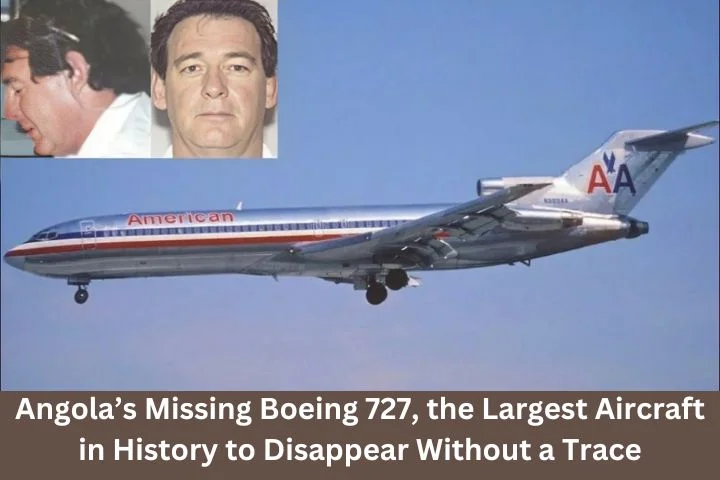In 2003, an old defunct Boeing 727 airplane sat on the tarmac of Quatro de Fevereiro Airport in Luanda, Angola. The large aircraft had been stripped and refitted and was now just days away from being moved and sold off to the highest bidder.
However, on May 25, 2003, something bizarre and unexpected happened that caused a decades-long aerospace mystery.
Two staff members who had been involved in the airplane’s refurbishment project were caught on camera sneaking onto the aircraft. One of the individuals was an American pilot and flight engineer, while the other was an airplane mechanic.
Neither man was qualified to fly a plane of such a large calibre, but that did not stop the 1975-built Boeing 727 from taking off into the skies with its lights off and without permission from air traffic control.
As the plane flew over the Atlantic Ocean and disappeared into the horizon, neither the aircraft nor the two crew members on board would ever be seen again.
It’s a mystery why these two individuals risked it all to steal this airplane and what happened to the missing Boeing 727 after all these years.
The History of Boeing 727 – N844AA
The infamous Boeing 727 with registration number N844AA was built in 1975 and operated by American Airlines for almost 25 years before becoming nearly defunct.
Once it was out of rotation for commercial flights, it was sold to Aerospace Sales and Leasing and was supposed to be converted for use by a Nigerian airliner called IRS Airlines.
However, it had sat grounded for over 14 months, accumulating more than $4 million in unpaid airport fees.
In May of 2003, the large aircraft remained on the tarmac of the Quatro de Fevereiro Airport in Luanda, Angola mostly unpainted, except for remnants of blue, red and white stripes from when it was in operation.
All of the passenger seats inside had been removed and instead, it was refitted to carry diesel fuel. IRS Airlines, who was leasing the plane from Aerospace Sales and Leasing, had plans to use it to supply fuel to diamond mines.
However, that deal fell through and IRS Airlines abandoned its plans.
Rather than continue to let it sit and collect dust and outrageous airport fees, Aerospace Sales and Leasing decided to repossess, refurbish and repurpose the plane. A team was deployed to make any necessary repairs to the aircraft to get it flight ready.
The Boeing 727 was going to be flown to Johannesburg to be sold off to the highest bidder, likely for parts as it wasn’t in the greatest condition.
Days before the plane was scheduled to leave, it was moved from the tarmac to the main runway in order to carry out final tests to ensure it was safe to fly.
The Day Of The Disappearance
On May 25, 2003, two men are observed on camera sneaking onto the parked Boeing 727. The men would later be identified as Ben C. Padilla, an American pilot and flight engineer and John M. Mutantu, a mechanic from the Republic of Congo.
Both individuals had been hired by Aerospace Sales and Leasing to work on the refurbishment of the airplane. While Padilla was a pilot, he was only qualified to fly small private aircraft.
Neither man was qualified to fly an airplane the size of a Boeing 727, which would ordinarily require three trained aircrew.
Yet, with all of the aircraft’s lights off, they moved down the runway and took off into the sky going southwest, without asking air traffic control for permission to fly.
No one had any idea where they were going and when air traffic tried communicating with the plane, they received no response. The transponder was turned off so it could not be tracked.
The Boeing 727 headed across the Atlantic Ocean with over 14,000 gallons of fuel, enough to fly up to 1500 miles without stopping.
Reports say that someone on the aircraft used the radio to request permission to land in the Seychelles Islands, which are located more than 3200 miles away from departure.
Meaning, the aircraft would have had to refuel at some point to make it such a distance, though there is no record of the plane ever entering a country to do so.
Permission to land was granted, but the plane never responded nor did it land. Neither the aircraft nor the two men piloting the plane would ever be seen again.
As this could have been an act of terrorism, both the FBI and the CIA quickly launched a full investigation to find the missing airplane. This happened only two years after 9/11, so tensions were high.
Unfortunately, there was no sign of the aircraft in the skies.
The Background Of The Thieves
What made this incident even more bizarre was the background of the two individuals who stole the plane.
Ben C. Padilla was a 50-year-old American pilot and flight engineer with two children and a fiancee of 15 years back home in Florida. His family said that he had loved airplanes ever since he was a child.
He had always been mechanically gifted and received his first certification to fly small planes when he was in his mid-20s.
Padilla had been hired by Aerospace Sales and Leasing to oversee the work that the mechanics were doing to refurbish the Boeing 727.
According to other staff members who worked with him, there was nothing out of the ordinary about his behavior in the days leading up to the vanishing airplane.
He did everything that he was supposed to do as part of the project, including overseeing the plane being moved to the main runway in anticipation of the upcoming flight.
There was no indication that he had planned to steal the airplane he had been working on.
As for John M. Mutantu, all that was known about him was that he was a resident of the Republic of Congo who had been hired by Aerospace Sales and Leasing as a mechanic.
When the FBI tried looking at his background as part of their investigation, they couldn’t find any information.
Nothing in either of their backstories indicates why either of these men took the missing Boeing 727.
Theories
The initial theory was that the theft of the aircraft was an act of terrorism. Officials at the FBI and CIA believed that the aircraft could be used as a bomb, which is why there was a search and investigation launched immediately.
As time passed, without the aircraft or crewmembers resurfacing, the terrorism theory dwindled.
One of the more popular theories about the missing Boeing 727 involves an insurance scam. The plane had been sitting at the airport, not being used, racking up fees while collecting dust.
In the condition it was in, Aerospace Sales and Leasing was going to have to sell it off for parts. However, now that it was missing, an insurance claim could be filed and paid out to the company.
Maury Joseph, CEO of Aerospace Sales and Leasing, had a shady history of falsifying financial statements and declaring bankruptcy with previous companies.
Some believed that he paid two of his staff members to get rid of the plane as part of an insurance fraud scheme, though eventually, the FBI would clear him of this theory.
The other theory was that the airplane crashed into the Atlantic Ocean never to be seen again. However, there has never been any evidence of this happening and no debris from the aircraft has ever been collected.
In the summer of 2003, just a few months after the plane disappeared, there was another aircraft spotted in New Guinea that matched the description of the missing Boeing 727.
Rumors swirled that it was the missing plane, only repainted and with new serial numbers. However, authorities were never able to verify this information.
Without a shred of evidence from the plane or any sightings of the two men who stole it, the missing Boeing 727 would become a decades-old mystery that has yet to be solved.
Without the imminent threat of a terrorist attack, the FBI felt there was no longer a need for an active investigation so they closed the case in 2005.






